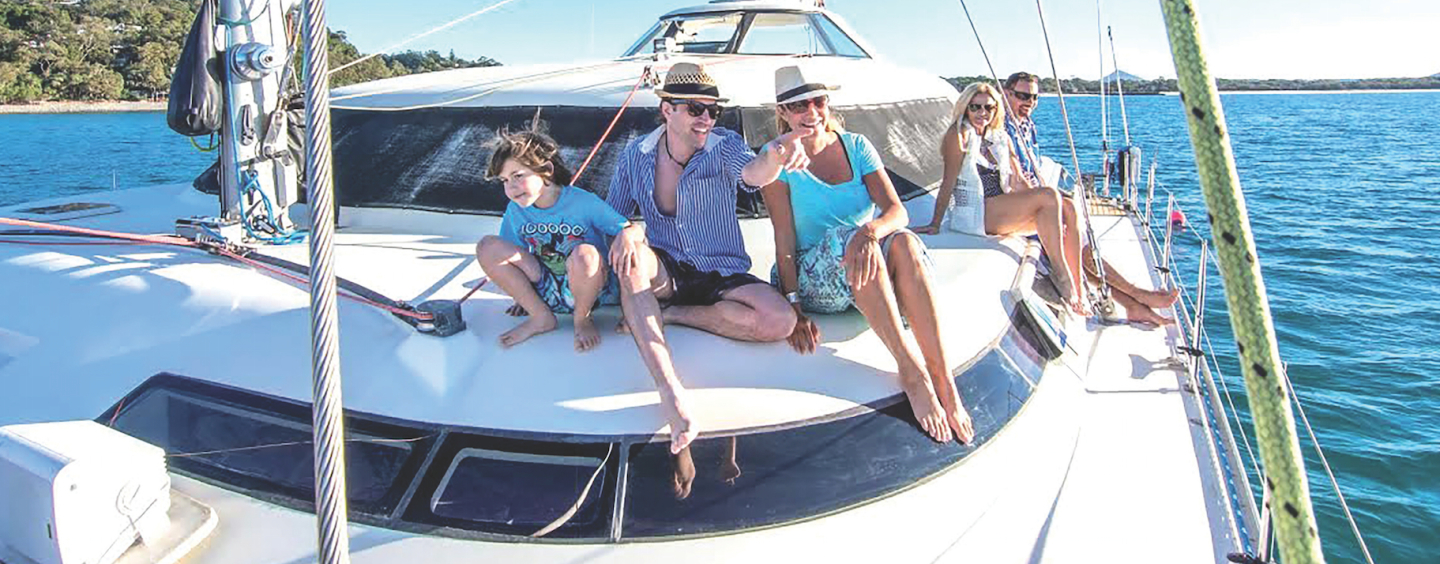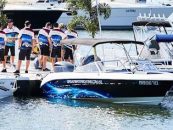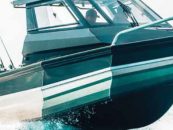Long-time monohull owner CAROLINE STRAINIG takes a walk on the dark side to see how monos and multis stack up when it comes to sailing and boating in South East Queensland. Will she swap allegiances? Read on to find out.
Someone asked me recently what type of boat is best for South East Queensland – a monohull or a multihull. As a monohull sailor, I only had one answer. But then, I thought, why not investigate the multihull, learn more about it from a devout ‘multihuller’, and compare with the mono? Off I trundled to do just that.
THE CASE FOR MULTIHULLS
Geoff Cruse, the Manly-based sailor who agreed to speak on behalf of multihulls, was a boat builder for 40 plus years producing Windspeed multihulls before becoming a marine surveyor. He has lost track of the number of multihulls he has sailed on. Today, he still races regularly on a Nacra 36 speed machine, and a Schionning 16 high-performance cruiser, among others.
His grin was a mile wide when I asked him what he loves about sailing multihulls. “I can sum it up in one word – fun,” he says. “It’s a speed thing. It’s so exhilarating passing other boats, and we sail right on the edge, lifting a hull and with the bows going under.”
Here are some of the other reasons Geoff thinks multihulls should be your first choice for our local waters.
Geoff explains that a typical 10-metre multihull draws from around 1.2 metres to as little as 0.45 metres if it has dagger boards and a kick-up rudder. “This means you can get in close and beach the boat. And at places like the Sandhills, this is fantastic experience,” he says.
He has wonderful memories of family holidays beaching their multihull, and letting the children run wild on the beach nearby while the adults relaxed on the boat.
The shallow draught also means multis can anchor closer in, where it is more sheltered. Geoff acknowledges some drop-keep monos can do the same, but says it is unusual to find a drop keel in a larger mono.
Geoff believes a multi is without parallel when it comes to space and comfort. “If you want the on-water equivalent of an apartment, you cannot go past them,” he says. “Yes, per foot overall length, they are more expensive, but that’s because you have much more room aboard.” He estimates a 10-metre catamaran would have as much living space as a 12-metre monohull.
He says multis sail flatter than a mono, and tells the tale of how a rose bowl left out on a table by mistake survived an offshore delivery. However, he admits they can still have a choppy action, particularly to windward offshore. So it is not always “sailing at its level best”, as multi lovers claim.
Safety-wise, Geoff stresses the cruising catamaran of today is a different creature from the high-speed racing machines we see capsizing in races like the America’s Cup. “Nowadays it would be very rare for a cruising cat to overturn,” he says. “Cruising monos should be compared with cruising multis, and the same for racers.”
He points out that, multis have multiple hulls instead of one, so there are two or three independent watertight floatation areas. “Multis are unlikely to sink when flooded or capsized because of this,” he says.
THE CASE FOR MONOHULLS
Just as Geoff finds sailing on multis fun, I find sailing on a monohull thrilling. It is that heeling feeling, as you go to windward, and the boat heels and settles into the groove. It just feels so – well – right.
When it comes to speed, a well-designed monohull can give you a more than acceptable turn of speed. Although the rule is that multihulls are faster, which makes for shorter passages and gives more chance of outrunning bad weather, there are monohulls that can do the same.
A monohull has less windage than a multi, making it easier to berth. In tricky situations, the multi is harder to berth. Moreover, because of its shallower draught and the extra windage, the multi swings differently at anchor to a deep-keel mono, so you need to be careful to allow enough swinging room when anchoring near monos.
The signs a monohull is overpowered are unmistakable, even to a novice. A mono will round up, heel excessively, and basically tell you where to go. A multi has very high initial stability in comparison, so it heels much less. Yes, there are some signs for a multi – they will heel slightly, start to bury a bow, and the steering will become heavier – but these signs are less obvious to inexperienced sailors.
Even a small monohull always has sufficient accommodation space for a comfortable overnighter. A $10,000 RL24 trailer-sailer has a vee-berth, and at least one-quarter berth. On the other hand, a small catamaran has minimal, if any, accommodation over the bridgedeck, so you need to buy a sizable multi before you can overnight in comfort.
Admittedly, multis do rule the roost when it comes to shallow draught most of the time. But an increasing number of monohull manufacturers offer shallow-draught versions, such as the beachable Sun Odyssey 33i from Jeanneau. Trailer-sailers are also outstanding in this respect.
A mono may not sail as flat as a multi, but a multi can still develop a jerky, sideways seasick-inducing motion, which some people find worse than a monohull’s. The sound of waves slapping on the underside of the multi’s bridgedeck when going to windward can also be annoying, which obviously does not exist on a mono.
In case of a capsize, the trusty mono will normally self-right. On the other hand, the multi will stay upside down, albeit with a stable platform while awaiting rescue.
Another tick on the plus side for monos is that they take up less space in a marina berth, so berthing fees are usually cheaper. It is possible, though, to pay lesser fees for a multi if you can snag an outside berth at a marina that does not charge extra for wider vessels.
THE VERDICT
Weighing up the pros and cons of both when it comes to the Gold Coast and Moreton Bay, I would have to say multihulls have a lot going for them when it comes to sailing and boating in this area. Yes, I admit it! However, until I win Lotto, I will keep sailing on my friend’s drop-keel trailer-sailer, which can do many of the same things a multihull can – albeit on a more modest scale.
PROS AND CONS AT A GLANCE
Multihull pros
- Shallow draught
- Ability to beach
- Space, glorious space
- Exhilarating speed
- Flatter sailing
. . . and cons
- Cost per foot length overall
- Higher berthing charges
- More windage
- Difficult to right after capsizing
- Less noticeable feedback from the helm, at least for novices
Monohull pros
- Cheaper per foot length overall
- Lower berthing charges
- Self-righting after capsize, normally
- That heeling feeling some sailors love
. . . and cons
- Deeper draught; although some shoal-draft/drop keel available
- Most cannot be beached
- Less space than the same length catamaran
- Slower, so less able to outrun bad weather
- Heeling at acute angles that can be uncomfortable
WHY IS A MULTIHULL THE BEST BOAT FOR MORETON BAY?
“Multihulls are ideal for our local waters mainly due to their shallow draught of around one metre and massive interior and exterior volume, which makes them perfect for family and friends to get away on for the day, weekend, or week. South East Queensland is multihull mecca on the Broadwater or out in the ocean.” – Rowan McMahon, Queensland state manager, The Multihull Group (national Lagoon distributors)
“The shallow draught typical of catamarans and trimarans allows access to the most remote anchorages on the Broadwater and surrounds. And their spacious living and entertaining areas all on the one level ensures you make the most out of your time on the water with loved ones.” – Mark Elkington, managing director, Multihull Solutions
“[There are] One hundred beautiful islands in an underrated location with a huge variety of environments. Much of the bay is simply inaccessible to deep-draught boats and untenable to boats, which roll at anchor. Sail a multi and get there quicker. Enjoy the sail, anchor flatter, relax on the tramps, and have fun.” – Andrew Crawford, SE sales representative, Multihull Central
“A sail or power catamaran makes so much sense for many reasons. They are ‘on the water’ rather than in it, which means that it takes very little power to propel the boat. [They are] brighter and better ventilated inside, provide a large and stable platform, offer privacy when guests are aboard, and their draught means you can anchor in shallow and less crowded areas.” – Ian Mackenzie, director, Catamaran Company
(May-Aug2017)






























